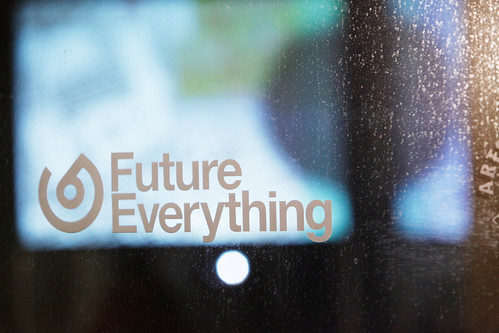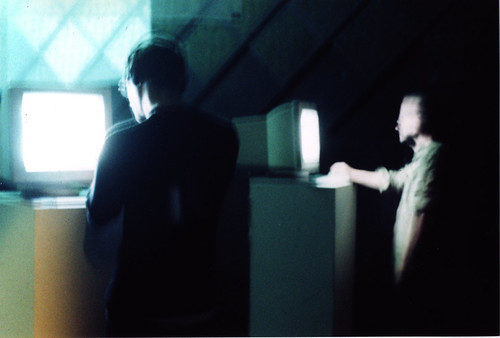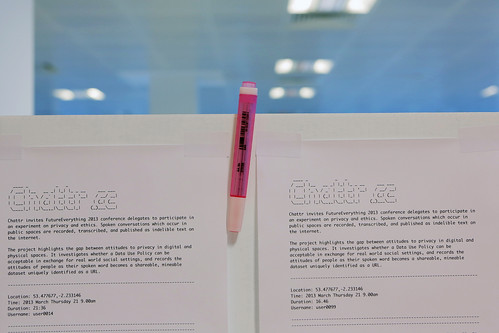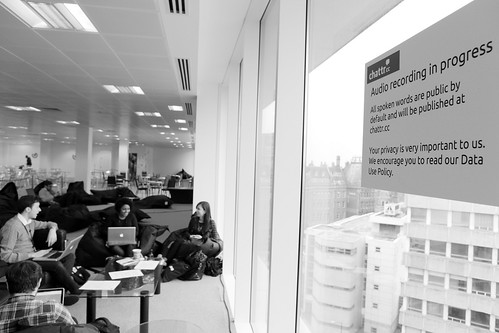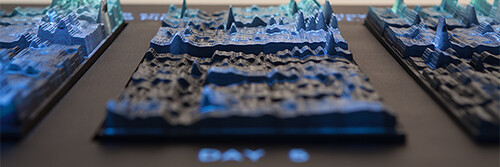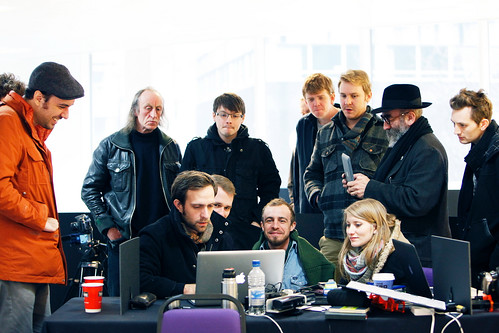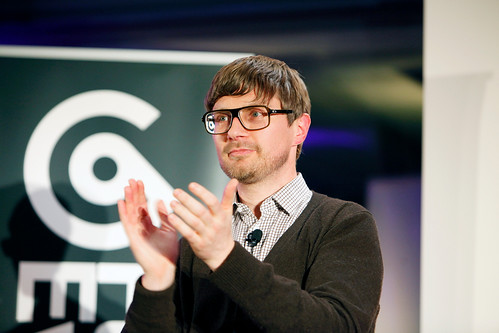Thursday, 12:59pm
16 May 2013
Innovating the future
FutureEverything founder Drew Hemment has been using art and design to ‘curate innovation’ since the dawn of internet culture

Following up from the FutureEverything Summit in Manchester, Linda Kwon talks with FutureEverything founder Drew Hemment.
A special edition of the FutureEverything Summit of Ideas & Digital Invention consisted of a two day conference nested within a broader programme of workshops, art, music, fringe events and an innovation challenge that took place in Manchester 21-24 March 2013. This year’s summit was the start of a two-year programme serving as a prelude to the coming twentieth anniversary in 2015.
FutureEverything, as defined by founder and CEO Drew Hemment, is ‘a place to discover the innovative ideas and people that are changing the world’. Cultural researcher and guest curator for this year’s summit, Jose Luis de Vincente explained their approach as seeking to be the point of convergence between communities of design, new media and technology in order to spark discussion while providing a space for enthusiasm, empowerment and critical engagement.
Birthing the future
Since its inception eighteen years ago, ‘FutureEverything’s journey has followed and helped to shape the emergence of today’s digital society’. Things have evolved such that the sphere of FutureEverything has moved beyond ‘specialist concerns [and now] impacts on every level of art, society and economy,’ said Hemment.
FutureEverything 2013.
Top: Drew Hemment.
All 2013 photos by TAPE.
On the pulse of digital culture since its nascence, Hemment describes how FutureEverything began. ‘I was inspired by the early flashes of digital culture, I wanted to create a space to conduct all that energy, where artists, coders and change makers can come together. It was clear in the early 1990s the Internet was going to change everything. We needed an event to work out the direction of travel, to try to influence this, steer it in interesting directions.’
What became FutureEverything was initially conceived as a platform for art and ideas and a place for creativity to flourish through play and experimentation. Their original moniker was Futuresonic and it was 1995. DVDs had just come out, Internet Explorer 1.0 had just been released, 2MB floppy disks were still widely used and this was the brief blip in Apple’s product history during which clones of their desktop computers were available. Those early days of Futuresonic were spent looking at immersive, collaborative online environments, haptic interfaces, hardware hacking, creative code and generative art.
The early days of Futuresonic.
Since those prescient beginnings, digital culture has become the ubiquitous background white noise of life today. And FutureEverything, renamed in 2010, has since become an annual festival dedicated to an open dialogue around technology and creative expression. Each year features a panoply of art and music events in addition to the conference. Collectively, these elements become the tangible evidence of imagined futures.
Chattr explanation on display at FutureEverything 2013.
An example of such an experience from this year’s summit was the Chattr lounge, which was located in the café. Chattr posed the question for discussion: How much of your data are you willing to leak into the public online domain? Entrance to the lounge was predicated on giving permission to be included in a public debate where any conversations within the Chattr confines were recorded with the intent of sharing them online. The experience was likened to the choice given by social media providers like Facebook who set user defaults to public. The Chattr description stated ‘Sign up to our terms, or you do not get the service you desire – the comfort of the Chattr lounge at the FutureEverything Summit,’ and the lounge was indeed more comfortable with its large enticing bean bag chairs.
Terms posted in the Chattr lounge.
Year-round innovation labs
Although the conference and events may be the foundation, FutureEverything is much more than an annual festival. In addition, FutureEverything operates innovation labs year-round that work on themed projects. The projects can run anywhere from three months to three years and often feed into the conference programme. The impetus for this year’s summit was to bring this work more to the fore.
Such projects have included Environment 2.0, which explored methods of observation and social sensing of environment and climate, as well as Open Data Cities which became the seed for the Greater Manchester Datastore (DataGM) and led to a partnership with the Open Data Institute. Another project of note was last year’s emoto data visualisation which captured global response to the London Olympic games via Twitter to create a visual representation online and in the form of a physical data sculpture. ‘The emoto data visualisation artwork for London 2012 was the first project to capture and visualise the online sentiments towards a major global event in real-time,’ explained Hemment.
Portion of the emoto data sculpture visualising data from Twitter response to London 2012.
Their newest project, Euporias, is a collaboration with the worlds leading climate science organisations looking at the role art and design can play in accurately communicating and mitigating uncertainty within the context of new forms of climate services.
These innovation projects and R&D work ‘engage government, design and development communities and the open data world to produce new work and ways of thinking. The Summit was a great place to discuss and present this work, as well as actively engage directly with designers, creative coders and developers to make new content,’ said Simon Webbon, FutureEverything Marketing Manager.
Such an eclectic variety of projects may prompt the question of how they go about choosing their projects. Hemment explained that ‘We do projects when we have a passionate belief they need to be done. Most are collaborative and involve people we want to work with. It is good to be challenged, to step off the deep end, and to collaborate with surprising bedfellows. We are activists at heart and have a naïve belief we can make things better.’
FutureEverything consists of a small core group based in Manchester, but it also includes an extensive worldwide network of collaborators self-described as ‘an alliance of artists, thinkers, innovators, makers and doers’.
James George leads the RGBD Toolkit workshop on depth enabled filmmaking with open source software using Kinect cameras and DSLR high res video. This years summit also showed the UK premiere of the extended cut of George’s new film Clouds, which was produced using the software.
With eighteen years of history, they have gained a unique frame of reference from their perch, ever facing the future. More recently, they have started looking back to develop a FutureEverything archive to map their work and ideas over time. This has also helped to cast their work in a new light. ‘FutureEverything has been defined by the now and the next thing. But coming up to a twenty year anniversary, we look at ourselves differently. We have become part of the history we foretold. This is not just an issue for us, new media art now has a mortgage and two kids. At the same time there is still dizzying change all around.’ mused Hemment on the perspective provided by the liminal spaces they inhabit. ‘And in our curatorial themes, we are definitely thinking of the very long term, the archeological, the meta structures we can glimpse in still shifting sands.’
Now that the summit has finished, FutureEverything has gone back into the lab to carry on down the path of innovative exploration. They are taking a step back to consider the bigger picture and simultaneously ‘rethinking what a digital culture festival can be at a time when digital culture is everywhere and everything’. That said, planning is already well under way for next year’s FutureEverything festival, taking place in Manchester in March 2014.
When asked what we should expect from FutureEverything in the coming years, Hemment’s response was quite simply, ‘the unexpected’.
Drew Hemment at the 2013 FutureEverything Summit
Eye is the world’s most beautiful and collectable graphic design journal, published quarterly for professional designers, students and anyone interested in critical, informed writing about graphic design and visual culture. It is available from all good design bookshops and online at the Eye shop, where you can buy subscriptions, back issues and single copies of the latest issue. You can see what Eye 84 looks like at Eye before You Buy on Vimeo.

